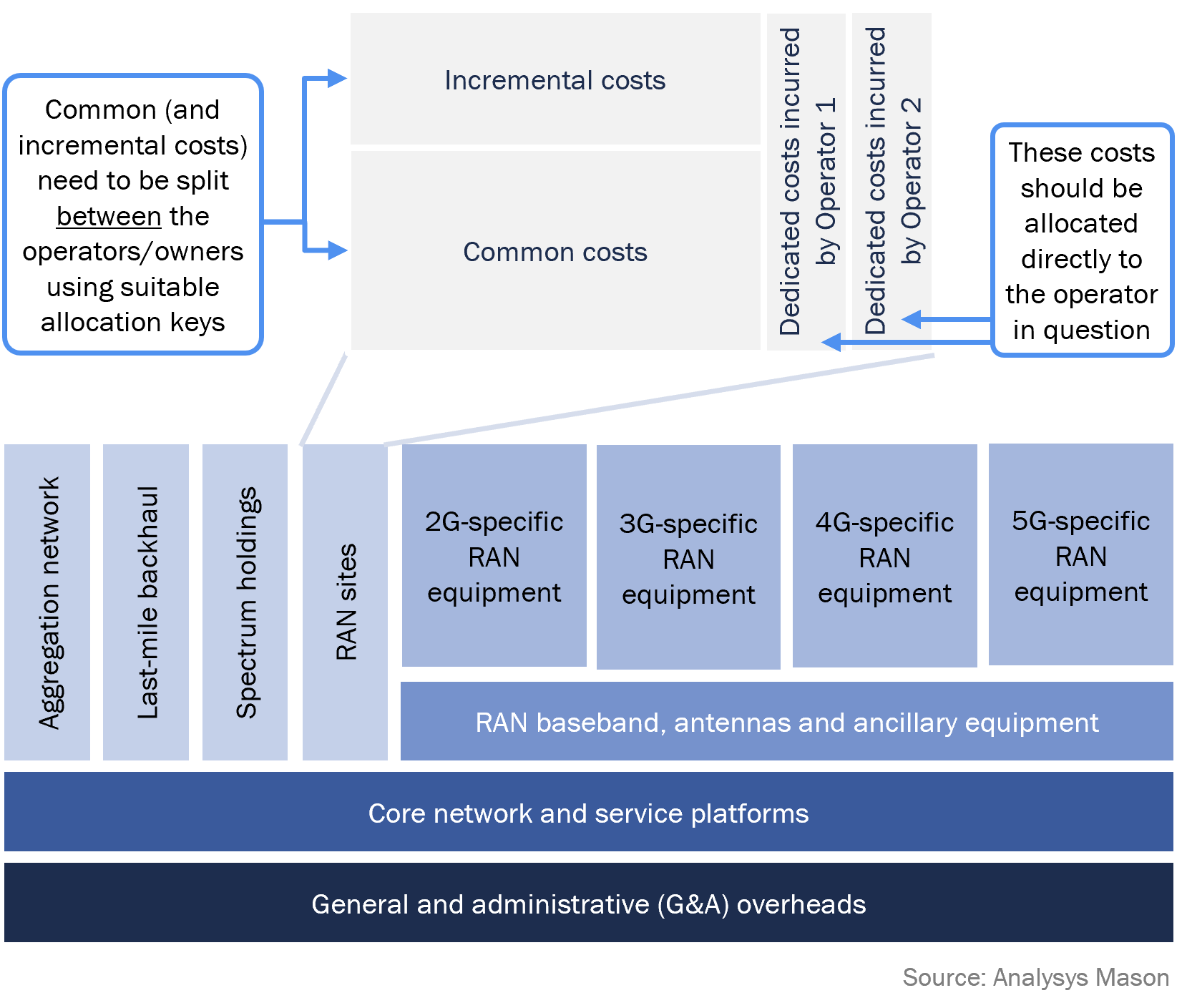Sharing the (network) bill: whose cost is it anyway?
Mobile operators are always seeking ways to reduce their network costs without sacrificing the quality of their service offering, while also investing in continued improvement in the network to stay competitive. One way to achieve this has been through sharing infrastructure, including the active equipment. Such commercial ventures will always bring their own challenges, since all parties involved want to ensure they are not paying more than their ‘fair share of the bill’.
Such arrangements have been in use since the mid-2000s but the landscape of mobile network deployment is getting ever more complicated.
- multiple radio access network (RAN) technologies that were once deployed side-by-side as separate electronic units are now being deployed as single RAN
- functionality that would have required deployment of hardware components is now being rolled out in a virtualised fashion
- the list of potential network upgrade options gets ever longer.
Working out a fair share of the bill is perhaps not as easy as it used to be
Splitting the bill between two parties – like families dining at a restaurant – is a useful starting point for comparison. Personal experience tells us that the simplest choice is to divide the bill equally, so each family pays the same amount. This is easy to do, and is fair as long as each family’s order came to a similar total price.
In a similar vein, if there are multiple tables of extended family and friends at the restaurant, then each family could only pay the bill for certain tables. This would be like a network being split geographically, with each party paying for the operation of their geographical regions.1
The bill can also be split person by person, based on the price list for what was ordered from the menu. Of course, this option only works if you have a price list for everything that was consumed, and there is a willingness to put in the time and effort to calculate each cost.
There are wholly different ways of looking at how the charges can be broken down for a restaurant meal. One could base the bill on the costs incurred by the restaurant: this would be like the two families paying their proportion of the restaurant’s rent and utility bills for the time they were there, plus the costs of the restaurant staff and the ingredients used for what the families ordered. The focus is therefore on the costs of the inputs, rather than the prices of the outputs. What this approach then requires is a piece-by-piece assessment of suitable rules to share each of these costs. This can be as generalised, or as detailed, as the owners think is necessary. While that may sound like a bit of an unusual and complicated way to split a bill in a restaurant, this is exactly how costs of shared networks are commonly split.
When defining the principles to be used for cost allocation in regulatory cost models, the emphasis is on the allocation of costs between the owners of the shared network, rather than the allocation of costs between the service volumes carried by the network. Cost causation is a foundation for these principles, as it can help govern a reasonable allocation. Cost causation is important in the restaurant illustration as well, since one family may feel aggrieved if they pay, for example, a share of the wine bill when they drank none.
In a mobile network, there can even be different effects to consider for each cost category, such as:
- costs that have to be paid in any event (‘common costs’)
- costs that vary with the volume of demand served by the network (‘incremental costs’)
- operator-dedicated costs (that should be paid by the operator causing the cost to be incurred).
An illustration of the cost categories in a mobile network and how different cost components within each category could be split between the parties concerned, is shown in Figure 1 below.
Figure 1: Cost components (and sub-components) for a mobile network

A cost-sharing approach may also need the approval of the regulatory authorities. They will be monitoring the situation as they will not want risks to competition as a result of the sharing agreement. Such concerns have caused delays in approval or even termination of agreements in the past.
There are best-practice principles for cost-sharing in mobile network joint ventures
Broadly, cost-sharing mechanisms should satisfy the following requirements – the UK regulator Ofcom references many of these in its own principles of cost recovery that it has applied since the mid-1990s.2
- Effective market competition: the mechanism should facilitate downstream market competition and promote efficient retail pricing by all parties concerned.
- Cost causation: costs should be recovered from the parties whose actions incurred them.
- Incentives for efficiency: efficient investments and operating costs for the network should be encouraged.
- Simplicity/practicality: complexity of an agreement should be kept to a minimum and the levels of data and effort required to complete the calculation should be manageable.
- Objectivity: the distribution of costs and benefits should be fair, neutral and reasonable between all parties concerned.
- Legality: owner-specific information must be handled in a manner compliant with competition law.
- Stability/resilience: the agreement should be durable and results should be predictable, even in the event of significant evolutions of the market or changes in either the network structure or the service offering.
- Accuracy: the actual costs of the shared network should be accurately reflected.
The increasing complexity of modern networks is also raising new problems that need to be captured effectively within any workable and future-proofed cost-sharing agreement. These include:
- the network-sharing architecture employed (MORAN and MOCN being the primary examples)3
- use of virtualised network functions and network slicing
- treatment of single RAN (if used), or any other radio technology upgrades
- increased use of traffic/service prioritisation
- deployment of private networks.
Whether a party is looking to enter an agreement, is already in an existing agreement, or needs to review a proposed agreement (which could include the involvement of the regulatory authorities), all of these issues create a minefield to navigate.
Analysys Mason has designed and/or reviewed several cost-sharing approaches, drawing upon our decades of experience in the techno-economic costing of telecoms networks. We would be pleased to discuss and assess the merits of the existing (or planned) approaches used in your shared networks to identify potential improvements. If this is of interest, then please contact Matthew Starling and Erik Widén for an initial discussion.
1 This has been used as a way to organise network sharing agreements, such as the joint venture between O2 and Vodafone in the UK for example.
2 Six principles (effective market competition, cost causation, cost minimisation/efficiency, practicability, distribution of benefits and reciprocity) were first set out by Oftel (Ofcom’s predecessor) in 1995 and they were subsequently adopted by the Monopolies and Mergers Commission in its report regarding telephone number portability that year. The only one of these principles that we do not list is reciprocity, although it could be applicable if the network sharing was via a roaming agreement (in which case the terms should be reciprocal).
3 MORAN and MOCN stand for multiple-operator radio access network and multiple-operator core network, respectively.
Article (PDF)
DownloadAuthor


